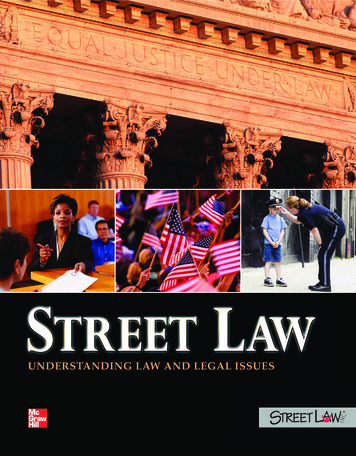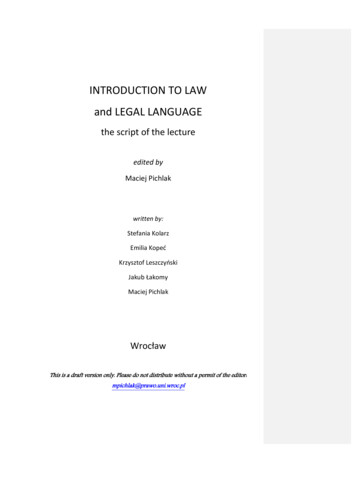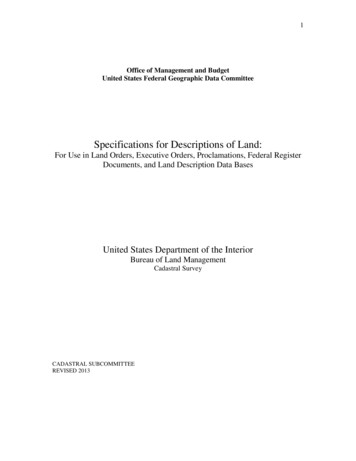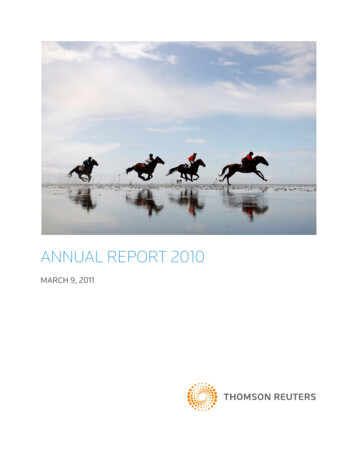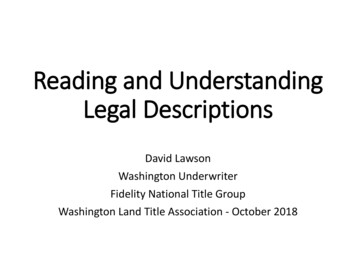
Transcription
Reading and UnderstandingLegal DescriptionsDavid LawsonWashington UnderwriterFidelity National Title GroupWashington Land Title Association - October 2018
This presentation focuses on legal descriptionswhich are not simple Lot/Block or condo unit, butrequire an understanding of how to interpret orlocate boundaries on a map. Statutory purpose of a legal description: To clearlyidentify property boundaries, sufficiently for a surveyorto determine boundary locations on the ground. CAUTION: Writing or amending legal descriptionsinvolves more complexity than might be apparent,requiring training beyond the scope of this presentation.It is strongly recommended that any new legaldescription or revision of an existing legal description bedouble-checked by a second experienced person.
Common Types of Legal Descriptions: Subdivision Recorded plat, short plat, etc. Sectional Federal governmental subdivision of Sections/Townships/Ranges Donation Land Claim Boundaries predate the federal government subdivision into Sections,but are reflected in those subsequent federal government surveys Metes and Bounds Boundaries described by bearings and distances Condominium Airspace described in a survey with lateral boundaries and upper/lowerelevations Unrecorded Plat This should really be a metes and bounds description, commonly withadditional reference to an unrecorded platAll legal descriptions are based upon survey information in somemanner, either original federal government surveys of sections,townships and ranges, or a survey of a plat, condo, etc.
Problematic legal descriptions Tax roll descriptions sometimes don’t contain enoughinformation to fully identify the property. But lack of plat recording data is normally not a critical defectif the plat name is complete & unique. Sectional descriptions based on theoretically perfectsections will create gaps or overlaps SE1/4 SE1/4 theoretically 1320’ x 1320’ containing 40 acres. W 660’ of SE1/4 SE1/4 does not equal WH of SE1/4 SE1/4 W 20 acres of SE1/4 SE1/4 does not equal WH of SE1/4 SE1/4 If two descriptions overlap, first split out of commonownership has paramount title.
Sample platted property legal description:“Lot , Block , (Plat Name), according to the plat thereofrecorded in (Volume/Page, or Book/Page, or Recording Number),records of County, Washington. (or some variation)
Sample condominium unit legal description:“Unit , Building , (Condo Name), according to theDeclaration recorded , Survey recorded , records ofCounty, Washington. (or some variation)Per Condominium Act RCW 64.34.212 “Description ofunits”: A description showing the name of the condo, therecording data for the declaration, the county/state, andthe identifying number of the unit is a sufficient legaldescription of that unit and all rights, obligations, andinterests established as appurtenant to that unit by thedeclaration or bylaws (such as assigned limited commonelements or the undivided interest in common elements).New WUCIOA: RCW 64.90.220 Description of units isalmost identical to the Condo Act provision.Statutes do not require mention of the condo survey, butmost title companies strongly prefer it be included.
Converting types of measurementsOld surveys often measured land in “Chains” or“Rods” carried by the surveyors. 1 mile 5,280 feet 80 chains 1 chain contains 100 links 1 chain 66 feet 4 rods 1 link 0.66 feet 1 rod 16.5 feet 25 links 1 acre 43,560 square feetOlder legal descriptions may even have used paces,but there’s no standard conversion.
Federal surveys: measured from theWillamette Meridian
Federal lands were surveyed into Townships &Sections for homesteading or sale Townships: intended to be 6 miles on each side Sections: intended to be one mile on each sideBUT IN REALITY, THEY ARE ALL DIFFERENT SIZESBASED ON FIELD SURVEYING DISCREPANCIES. Federal surveyors placed monuments to establishthe corners of sections and quarter sections. Rugged terrain and other factors preventedsections from ever being perfect square miles. This is the source of many gaps and overlaps oflegal descriptions.
Townships contain 36 Sections, eachapproximately 1 mile square
Sections were surveyed into quarters andcommonly sold in smaller portions
Read Sectional descriptions “backwards”Example: The N 200 feet of the E half of the NE 1/4 of the NE1/4 of the SE 1/4 of Section 8, Township 25 N, Range 5 E, .
Acreage legal descriptions Because Sections were theoretically a square mile andshould contain 640 acres, descriptions based on acreage arenot uncommon. Example: “The North 15 Acres of the NW 1/4 of the SE 1/4of Section .”
Irregularities in sections are dealt with through creationof Government Lots. Meander lines are surveyed linesapproximating the boundaries of navigable water.
Plats and similar subdivisions A platted lot legal description incorporates thesurveyor’s lot boundaries by reference to that plat. Like any other survey, plat surveys can includeerrors, especially in older plats. Don’t be surprisedif a new survey shows discrepancies.
Conventions in describing lot boundaries N, S, E & W, vs. Northerly (NY), SY, EY & WY, vs NEY,SEY, NWY & SWY
Conventions in describing corners
Divisions of a larger lot Parcel A: The W 50‘ of the Lot. (A 50 foot strip closest to the W line) Parcel B: The E 50’ of the W 100 ‘ of the Lot. (A 50 foot strip closest tothe E line of the W 100’) Parcel C: The E 50’ of the W 150‘ of the Lot. (A 50 foot strip closest tothe E line of the W 150’) Parcel D: The N 50’ of the Lot, EXCEPT the W 150 ‘. (Describes the N 50feet of the entire Lot, then cuts away the westerly 150 feet) Parcel E: All of the Lot, EXCEPT the N 50’ thereof, and ALSO EXCEPTINGthe W 150 feet thereof. of the Lot, EXCEPT the W 150 ‘. (Describes theN 50 feet of the entire Lot, then cuts away the westerly 150 feet)
Dangers in interpreting descriptions!Where is the Westerly 50 feet of this lot?
Or the westerly 50 feet of this lot?
Metes & Bounds (Bearings & Distances) Bearing: an angle measured easterly or westerly froma line pointing north or a line pointing south. A circle has 360 degrees (360 ) Each degree is divided into 60 minutes (60’) Each minute is divided into 60 seconds (60”) There are 90 degrees between a line pointing N and aline pointing E (or between S & W, or S & E, or N & W) All bearings are phrased as the angle that the line isveering easterly or westerly from a line pointing eitherN or S. N 7 E means a line rotated 7 degrees easterly of a linepointing N (a line that is just slightly easterly of N). S 89 W means a line rotated 89 degrees westerly of S (aline that is slightly southerly of W).
Bearings:
Where are North, South East & West? “NORTH” can have different meanings Magnetic North vs. True North vs. along or parallel to aN-S Sectional line or a N-S lot line E & W can have different interpretations, too, being atright angles to a N-S line, or parallel to a Sectional line. Each line has two bearings associated with it.S82 26’13” W follows the line in a SWY direction, startingfrom the E end. But the same line’s bearing is N 82 26’13”E when starting from the W end. Which way are yougoing?
Structures of metes & bounds descriptions Preamble: That portion of (identifysection/township/range or portion thereof, orLot/Block) described as follows: Identify the “Point of Beginning” or “True Point ofBeginning” (TPOB) of the parcel boundaries, whichoften requires starting (“commencing”) at some otherknown point, then describing how to get to the TPOB; Followed by metes and bounds which follow theperimeter of the property, returning to the TPOB; The word “thence” is commonly used at the start of eachsubsequent segment of the boundary being followed. Subparagraph(s), if needed, excepting portions (roads,etc.); AND/OR subparagraphs adding more land.
Exceptions from legal descriptions It is common for a description to except one or moreportions which lie within roads, or were previouslysold to someone else, or are being retained by theseller: EXCEPT the E 30 feet for road; ALSO EXCEPT the N 100 feet of the west 60 feet thereof. Beware of the “double negative” effect of excepting aportion, then excepting another portion. Is it exceptingtwo different portions, or is it excepting only the firstportion, then adding part of that first portion back intothe final boundaries? (Pay attention to phrasing and punctuation. Finalinterpretation may depend on historical chain of title.)
Example: Lot 1, followed by: EXCEPT the W 100 feet; ALSO EXCEPT the south 60 feet thereof. EXCEPT the W 100 feet, less the south 60 feet thereof. EXCEPT the W 100 feet, EXCEPT the south 60 feet thereof. EXCEPT the W 100 feet; EXCEPT the south 60 feet.
Getting to the True Point of Beginning Beginning at the SEcorner of the NE ¼ ofSection ; runningthence Beginning at the NWcorner of Lot 10; runningthence
Beginning at the NE Beginning at thecorner of Lot 5, saidintersection of the SWYcorner being at themargin of State St. andintersection of thethe N margin of “A” St.;centerlines of 15th Avethence and Johnson St.; thence
Understanding “ties” and “more or less”A metes & bounds line can include a “tie” forcing the line togo to a particular point or in a certain direction. Any stateddistance is really “more or less” even if not phrased that way: Thence NEly to the SW corner of the land conveyed toSmith by deed recorded ; (the angle and distance arewhatever it takes to reach that corner) Thence S 72 W 400 feet to the shore of Lake ; (this lineis lengthened or shortened to reach the shore) Thence N 38 E 726.35 feet to the NE corner of the NEquarter of Lot ; (both the angle and distance areadjusted to actually reach that corner) Thence along Wolf Creek N 23 W 76 feet to a line whichbears S 38 36’14” W from the TPOB; (two ties, onefollowing the creek meanderings, not the bearing, theother creating an ending point that must be where thatline to the TPOB intersects the creek)
Standard curves are part of the arc of a circle.They can be described by: the direction of the curve, left or right, based uponwhether the curve is veering to the left or right asyou follow the curve (or concave in a particular direction) the radius length the radial bearing (angle to the center of the curve) and either: the length of the curve as measured along its arc,OR a central angle (angle between the radial bearing atthe beginning of the curve and at the end of thecurve), OR a long chord bearing and distance.
Curve measurements & relationships
Tangent curves, tangent lines:”Tangent curve”: a curve whose radius bears 90 from the last line.** We should assume a curve is tangent unless stated otherwise!The 1st sketch shows the end of a straight line, continuing thence ona tangent curve to the left with a radius of 100’, central angle of46 30’ and an arc length of 79’.The 2nd sketch shows the boundary continuing on a line tangent tothe end of the curve.
Compound, reverse and non-tangent curves“Compound curve”: a second curve with a different radius.“Reverse curve”: a second curve bending in the opposite direction. Reverse curve: Compound curve: Non-tangent curve:
Comparing a description to a survey –check the “Legend” for types of lines
require an understanding of how to interpret or locate boundaries on a map. Statutory purpose of a legal description: To clearly identify property boundaries, sufficiently for a surveyor to determine boundary locations on the ground. CAUTION: Writing or amending legal descriptions involves more complexity than might be apparent,
